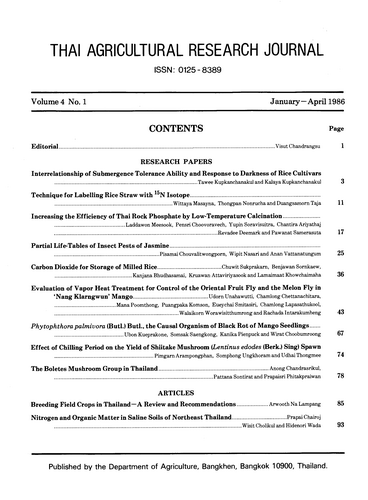Interrelationship of Submergence Tolerance Ability and Response to Darkness of Rice Cultivars
Abstract
To study the response of rice cultivars to complete darkness and flooding tolerance, 20 cultivars of known but with varying degrees of complete submergence tolerance ability, were grown in pots under open-air conditions in the Central Plains Region of Thailand in 1986. At 45 days after sowing , pots of each cultivar were exposed to four different treatments - control with shoots in air, complete darkness with shoots in air, complete submergence in 120 cm water, and complete submergence in 120 cm of water with 50 percent shading. After ten days of the treatments, the pots were returned to normal conditions for 10 days and information on cultivar responses mesured.
In general, the cultivar rankings were similar for tolerance of complete darkness and tolerance of complete submergence. Under complete darkness the rapid disappearance of chlorophyll was closely correlated with a cultivars inability to tolerate flooding submergence. Cultivars of floating rice responded to complete darkness and complete submergence with leaf sheath, leaf blade and internode elongation; however, the components elongated more in complete darkness than with complete submergence. The submerged treatment with 50 percent shading gave a similar result to the submerged treatment alone; the water was very turbid in both treatments. It was concluded that screening for complete submergence tolerance ability could probably be effectively and efficiently achieved by examining the response to darkness.
Downloads
Published
How to Cite
Issue
Section
License
Thai Agricultural Research Journal



